| Columns Retired Columns & Blogs |
Stereophile has reviewed both of these. I was wondering how you folks feel about these two compared to each other ?
The Imagine B is very similar to PSB's Imagine T tower model, which Kalman Rubinson reviews elsewhere in this issue. The B uses just one of the T's reflex-loaded 5.25" woofers instead of two, but appears to have the same titanium-dome tweeter, so it should be very similar to the larger speaker in most respects. The B's voltage sensitivity was to specification, at 87dB(B)/2.83V/m, or 1dB below that of the Imagine T. The B's impedance with its port open (fig.1) dipped to 3.3 ohms in the lower midrange, with a combination of 5.1 ohms magnitude and an electrical phase angle of –49° at 115Hz that will stress amplifiers or receivers not rated into 4 ohms. But the B is otherwise a relatively easy speaker to drive.
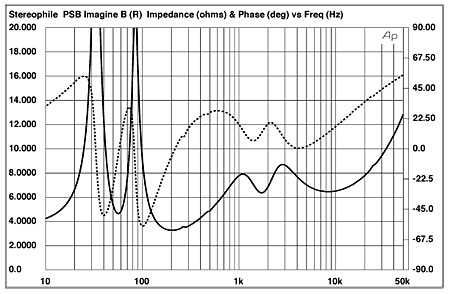
Fig.1 PSB Imagine B, electrical impedance (solid) and phase (dashed), port open (2 ohms/vertical div.).
With the port blocked, the impedance (fig.2) becomes that of a sealed box tuned to 68Hz, implying only modest bass extension. Like the T's, the B's impedance has a serious glitch just below 300Hz; also like the T, the B's cabinet has a severe resonant mode in this region (fig.3). But as JM didn't remark on any congestion in the lower midrange, I must assume that this behavior looks worse than it sounds.
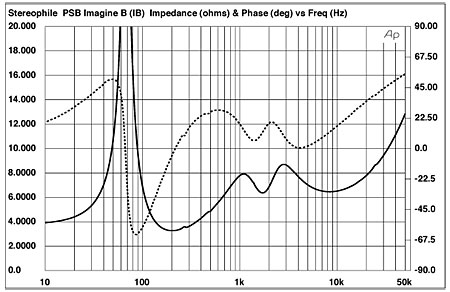
Fig.2 PSB Imagine B, electrical impedance (solid) and phase (dashed), port closed (2 ohms/vertical div.).
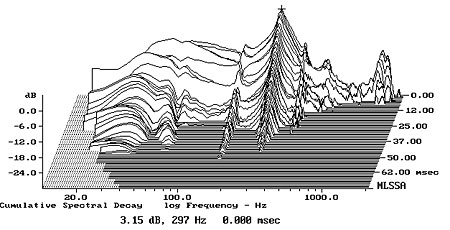
Fig.3 PSB Imagine B, cumulative spectral-decay plot calculated from the output of an accelerometer fastened to the center of the sidewall (MLS driving voltage to speaker, 7.55V; measurement bandwidth, 2kHz).
The saddle centered on 58Hz in the impedance-magnitude trace in fig.1 suggests that this is the tuning frequency of the rear-facing port, and indeed, with the port open the woofer has the expected notch in its nearfield response at that frequency (fig.4, green trace). The port (blue trace) peaks between 40 and 90Hz, with a smooth rolloff above that region, broken only by some kind of resonant peak just above 900Hz. This peak is low enough in level that, in combination with the fact that the port faces away from the listener, it probably won't give rise to coloration. Higher in frequency, both the woofer and tweeter (fig.4, red trace) are respectably flat within their passbands, with the tweeter then offering the usual metal-dome resonant peak at around 26kHz, which is high enough in frequency to have no audible consequences. (CDs, which are band-limited to 22kHz, will not provide enough energy to excite this resonance.) The crossover appears to be set at 1.8kHz, with steep filter slopes, though the woofer's low-pass rollout is slower than the tweeter's high-pass rollin.
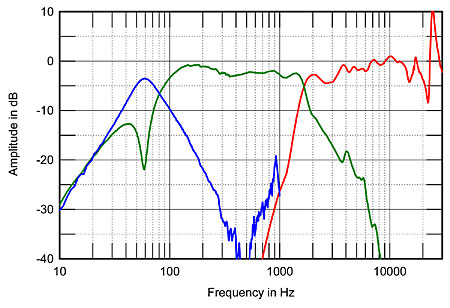
Fig.4 PSB Imagine B, acoustic crossover on tweeter axis at 50", corrected for microphone response, with the nearfield responses of the woofer (green) and port (blue), scaled in the ratio of their radiating diameters.
Above 300Hz, the blue trace in fig.5 is the Imagine B's farfield response on the tweeter axis with the grille removed, averaged across a 30° horizontal window, while below that frequency it shows the complex sum of the nearfield woofer and port outputs, weighted in the ratio of their radiating diameters. The slight rise in the upper bass is entirely due to the nearfield measurement technique; the B is tuned to be maximally flat, so I am not sure why JM felt the speaker's low frequencies sounded a bit plummy. With the port blocked (fig.5, red trace), the Imagine B rolls off smoothly below 120Hz with the expected second-order slope, reaching –6dB at the tuning frequency of 65Hz. If you compare this graph with the Imagine T's response (fig.5 in that review), you can see that the tower speaker's low frequencies extend around 10Hz lower than the bookshelf's in both conditions.
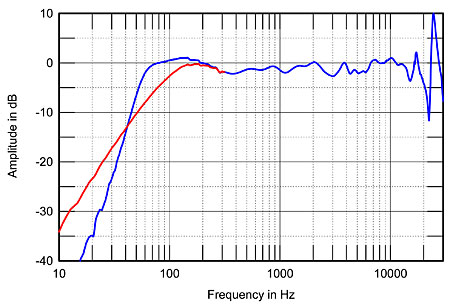
Fig.5 PSB Imagine B, anechoic response on tweeter axis at 50", averaged across 30° horizontal window and corrected for microphone response, with complex sum of nearfield woofer and port responses plotted below 300Hz (blue), and with woofer response with port closed (red).
John Marks described the Imagine B's midrange as being "ever so slightly dry, leaving the impression of something of a 'smile' equalization (so called because that's what a mixing board's sliders look like when such an EQ has been set)." Fig.5 shows that he was probably reacting to the slight rise in output above 6kHz. As with the Imagine T, however, there is a little too much overlap between the woofer and tweeter outputs in the B's crossover region, which leads to a slight excess of energy between 1.5 and 2.2kHz that will accentuate recorded detail without adding any forwardness to the speaker's character.
The Imagine B's horizontal dispersion is almost identical to that of the T (fig.6). Suffice it to say that it is textbook in the evenness and smoothness of the off-axis behavior. In the vertical plane, the Imagine B's dispersion (fig.7) indicates that the speaker should be used on high enough stands to place the listener's ears on or just below the tweeter axis. Listen seated too high, or while standing, and a suckout develops in the crossover region.
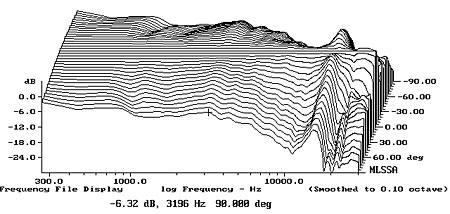
Fig.6 PSB Imagine B, lateral response family at 50", normalized to response on tweeter axis, from back to front: differences in response 90–5° off axis, reference response, differences in response 5–90° off axis.
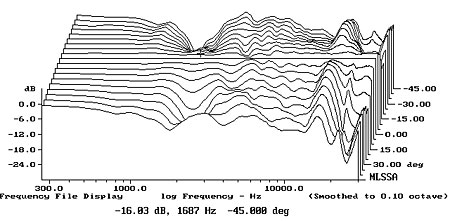
Fig.7 PSB Imagine B, vertical response family at 50", normalized to response on tweeter axis, from back to front: differences in response 45–5° above axis, reference response, differences in response 5–45° below axis.
In the time domain, the Imagine B's step response on the tweeter axis (fig.8) is identical to that of the T, with both drivers connected in positive acoustic polarity. Other than a slight step at the cursor position (3.8kHz), the B's cumulative spectral-decay plot on the tweeter axis is superbly clean (fig.9).
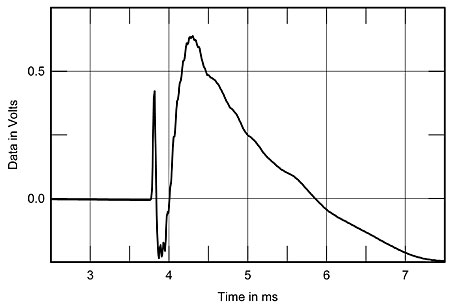
Fig.8 PSB Imagine B, step response on tweeter axis at 50" (5ms time window, 30kHz bandwidth).
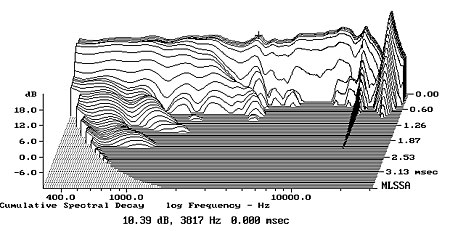
Fig.9 PSB Imagine B, cumulative spectral-decay plot on tweeter axis at 50" (0.15ms risetime).
PSB's Imagine B offers excellent measured performance that is commendable at any price, let alone in a speaker costing only $1000/pair. I look forward to auditioning it in my own system. As John Marks concluded in February, "PSB's Imagine B is an important loudspeaker."—John Atkinson

Stereophile has reviewed both of these. I was wondering how you folks feel about these two compared to each other ?

From all my readings, and experience, this is the problem with all small speakers. Ok, maybe there are a few small speakers that have good bass (PSB twenty22?), but they are so expensive you might as well buy a tower. So, wouldn't a sub (or two) resolve this problem, and also add some other benefits (like offloading the imagine B's so their sound would be even better, etc..)?
The question I've been pondering this weekend is this: given a set price to spend on speakers (say $2000), is it best to buy two towers/floorstanders ($1000/each), or, two bookshelf speakers ($750 each) and a $500 sub?
For example, here are two options:
System 1: 2 Imagine Bs and two Imagine subs
System 2: 2 Imagine T's
Both speaker systems are roughly the same cost - $2000.